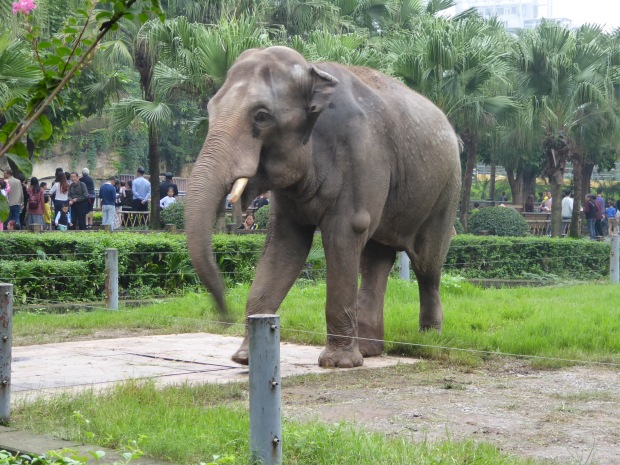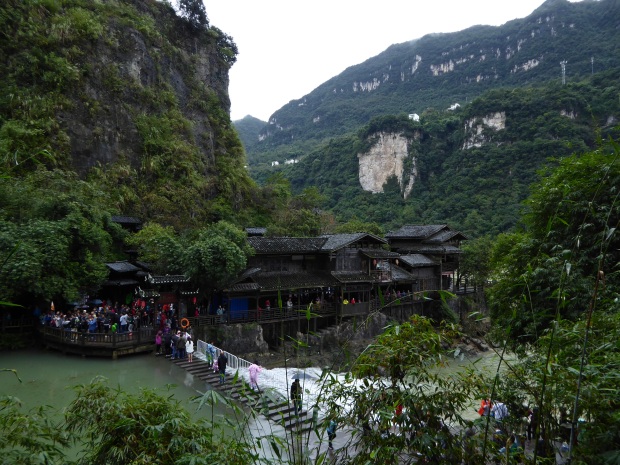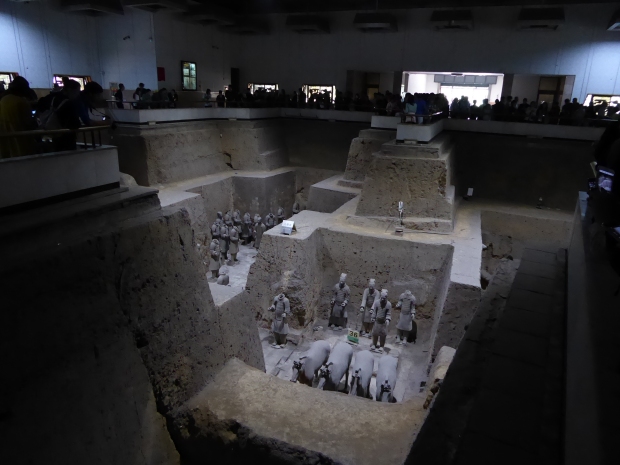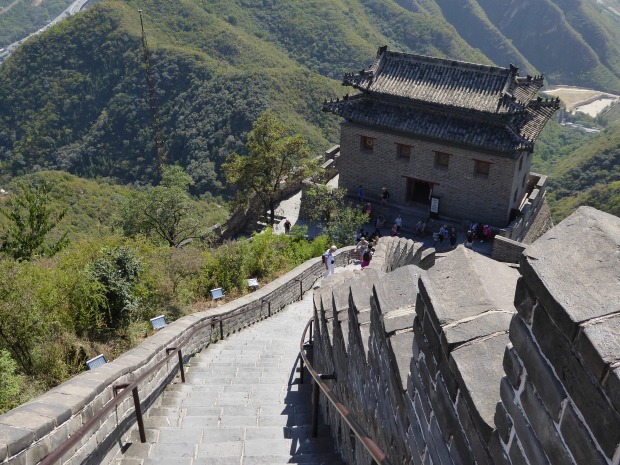My first visit to Beijing was in 1997. My, how things have changed in twenty years. I recall back then flying in to a small, drab airport that reinforced the feeling of being in a third world country (the current airport was under construction at the time). There was very limited car traffic and the roads were clogged with thousands of bicyclists. Central Beijing felt like a relatively small city (for China) that was easy to walk.
The city has expanded and changed dramatically in the past 20 years, but even so, the key tourist sights are still there and just as amazing now as they were then. We even lucked out on this last trip and had beautiful, clear weather rather than the common heavy gray smog.
In this post I’ll share several of the sights we visited on the first day of our China tour.
Temple of Heaven
This is one of the sights I had visited previously during a business trip to China (see my post here). The Temple of Heaven is a postcard symbol of Beijing. The Emperor would make his way from the Forbidden City to this temple to pray for good harvests each year.

A view of the Temple of Heaven.
The thing I noticed on this visit was the many senior citizens playing card and other games along the entrance corridor to the Temple, probably because it was a beautiful day and the Temple’s grounds are a park-like oasis in a very busy city.

Playing cards near the entrance to the Temple of Heaven.
Hutong Area
I had not been to this area of Beijing previously and I would have loved to explore it further. The word Hutong refers to traditional Chinese neighborhoods with narrow alleys, streets and homes with hidden courtyards, and that’s exactly what this area is like, along with some pretty lakes and park-like areas.

The peaceful setting of the Hutong Area.

On our rickshaw ride in the Hutong Area of Beijing.

Another view of the shops in the Hutong Area.
Many Hutongs have been demolished with the rapid growth of Beijing and the government seems intent on preserving what remains of these examples of Chinese history and culture. We took a rickshaw ride through the old streets and ate lunch here in a person’s home. Some Hutongs date back to the 13th century.

Our tour group having lunch (which was one of our best meals) inside a person’s home in the Hutong Area of Beijing.
Tiananmen Square
Beijing is laid out in a series of concentric circles, and at the center of Beijing lies Tiananmen Square. Tiananmen Square is probably best known to people in the U.S. as “ground zero” of the student uprising in 1989, which is known locally as the “June 4th incident”, where thousands of students camped out in the Square and were eventually forced to flee the troops and tanks sent to clear the Square. In the process of squelching the protests several hundred demonstrators were killed.

Beautiful displays in Tiananmen Square in preparation for the National Holidays. The entrance to the Forbidden City is in the background. The Square can hold one million people.

The Monument to the People’s Heroes in Tiananmen Square. Dedicated to the martyrs of the Revolution. The monument is 10 stories high. In the background is the Great Hall of the People, used for legislative and ceremonial activities.

Worker’s Statue, Tiananmen Square.
This historic, huge square is surrounded by a national museum, the mausoleum of Mao Zedong, a Great Hall and other government buildings. The Square is used for public events, government celebrations and as the main route for entrance into the Forbidden City, the main attraction in central Beijing.
Forbidden City
The Forbidden City is directly north of Tiananmen Square and it’s called the “Forbidden” City since no one other than members of the Imperial Court or special dignitaries were allowed inside. There is a specific route from south to north that you follow through the Forbidden City, the photos below are in the order of our visit from the south entrance to north entrance.

Entrance to the Forbidden City is through Tiananmen Tower, located just to the north of Tiananmen Square.
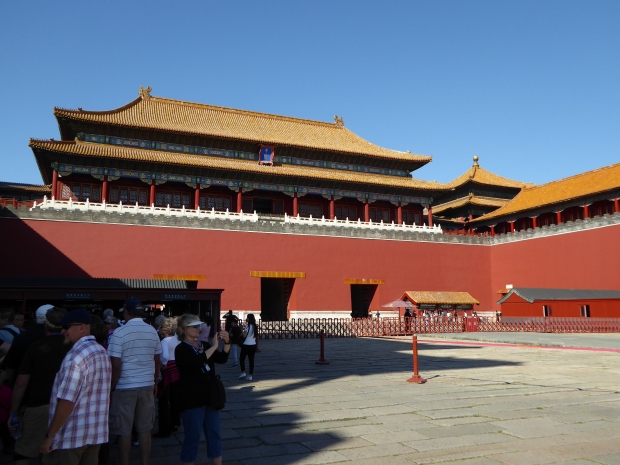
The Meridian Gate is the actual entrance to the Forbidden City and lies north of the Tiananmen Tower.
This was the Imperial Palace of China for 500 years, from the early 1400’s to the early 1900’s. The emperor would live, work and receive audiences here, and oversee the care of his thousands of consorts and concubines.

The Gate of Supreme Harmony provides access to the Hall of Supreme Harmony and the surrounding courtyards.

After the Gate of Supreme Harmony is this courtyard, with the Hall of Supreme Harmony in the background. It is one of the largest wooden structures in China and the largest Hall in the Forbidden City.
More than a million workers labored for 14 years to build the enormous palace complex and surrounding Tongzi Moat. The palace includes almost 1,000 buildings and covers an immense area. Only the Palace museum, main halls, gates and squares are open to tourists, and disappointingly, in some cases a direct view into the halls for photos was not allowed. I have no idea why. Be prepared for a LOT of walking.

From the steps of the Hall of Supreme Harmony looking southeast.

It was difficult to get a good photo of the interior of the Hall of Supreme Harmony due to barricades surrounding the entrance.

Interior of the Hall of Central Harmony. Once again, it was impossible to get a good view of the main throne area.

The Large Stone Carving, behind the Hall of Preserved Harmony. Anyone caught touching this carving during the time of the Emperors would receive the death penalty!

The Gate of Heavenly Purity leads to the last set of Halls and Palaces before the Imperial Gardens at the north end of the Forbidden City.

The Palace of Heavenly Purity. Intricate stone carvings are found everywhere in the Forbidden City.

Hall of Union and Hall of Earthly Tranquility.

Hall of One Thousand Autumns, Imperial Gardens of the Forbidden City.
While audioguides are available, the English signage is good throughout the Forbidden City. Surprisingly on the day of our visit, the City was not terribly crowded, probably because we were there just prior to the start of the Chinese National Holiday. The palace receives 15 million visitors annually.
2008 Olympic Venues
We made a quick stop at the sight of the 2008 Olympics, hard for me to believe it’s been 10 years since Michael Phelps won a world record 8 gold medals in swimming in Beijing. Of course, the event locations are spread out over a large area, and there is no one location or overlook to view the entire site, but our guide and driver were kind enough to stop and let us at least get a quick glimpse of where some of the main events were held.

A view of the Aquatic Center where Michael Phelps won his 8 gold medals and the “Birds Nest” arena behind it from the Beijing 2008 Olympics.
In my next post, we’ll visit the Summer Palace and the Great Wall.
















